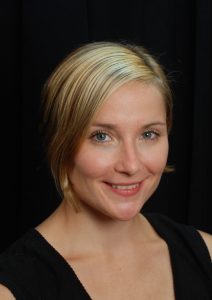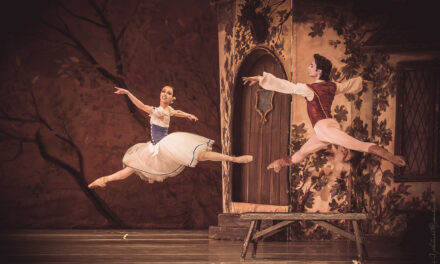April 16 marks the 100th birthday of American dancer and choreographer Merce Cunningham. Born in Centralia, Washington, Cunningham first experienced dance studying tap with local teacher, Mrs. Maude Barrett. He later attended the Cornish School in Seattle, headed by Nellie Cornish, to study acting, and it was there that Cunningham first came in contact with the Martha Graham technique while studying with Bonnie Bird. He then met Graham during a summer program at Mills College and acting on her encouragement, Cunningham moved to New York City in 1939 where he performed with the Martha Graham Dance Company for six years. In April of 1944, he presented his first solo concert in New York with American musician and composer John Cage, who became his life partner and frequent collaborator until Cage’s death in 1992. Cunningham died in New York City on July 26, 2009.
The Merce Cunningham Dance Company (MCDC) was founded in 1952 with dancers Carolyn Brown, Viola Farber, Remy Charlip, Jo Anne Melsher and Paul Taylor. John Cage was the Music Director and painter Robert Rauschenberg became the company’s set and costume designer. Over the years the company performed in nearly every major city around the world, and the list of dancers, composers, set designers and artists who worked with the Cunningham company grew far too long to mention here. Works by Cunningham have been re-staged on major modern and ballet companies as well as on dance students in universities and conservatories around the world. Former company members and dancers who trained with Cunningham have now spread out around the globe, helping to keep the Cunningham’s technique and choreographic legacy alive.
This article is not, however, about the history of Merce Cunningham and his company. It is to announce the performances of Merce Cunningham: Night of 100 Solos occurring simultaneously in Los Angeles, New York and London on Cunningham’s 100th birthday, Tuesday, April 16, 2019. As part of the year-long Merce Cunningham Centennial Celebration, the Night of 100 Solos is an enormous project that began over a year ago and involves dancers from multiple countries and dance backgrounds; none of whom were members of the Merce Cunningham Dance Company.
In Los Angeles, the Night of 100 Solos will be presented by CAP UCLA in Royce Hall at 8pm (PDT). The other two venues where the Event will be presented are the Barbican in London and Brooklyn Academy of Music (BAM) in New York. The dancers for Los Angeles performances were selected by former Cunningham Company members Andrea Weber and Dylan Crossman. Weber performed with the MDCD from 2004 to 2011 and Crossman from 2009 to 2011. The NY cast was chosen by Patricia Lent and Jean Freeburg, also former members of the MCDC.
Weber explained that the process began with a conversation back in November of 2017. First, she and Crossman put together a long list of dancers who had either studied directly with Merce Cunningham or who had had some training in his technique. For Los Angeles, Weber said that they had originally wanted at least half of the cast to be from LA, but circumstances prevented them from reaching that goal.
The cast list ended up including dancers from Los Angeles, New York, Houston, Chicago, Seattle, Portland, ME, Boston and Vermont. There were more dancers from LA on the original list, but three had to drop out. Weber was very sensitive to the fact that there were other dancers who were qualified to perform the work, or who wanted to participate, but there was a deadline to meet. She had to make her decisions in time for the press releases to go out, plus some recommendations of names reached her late. Due to the time constraints, another element in the selection process was the reality that dancers had to be quick studies and technically proficient to accomplish the hard-core part of the Cunningham technique. It was also important to Weber, the producers and the presenters that the selection be diverse in age range and experience. Hopes were to include more international dancers, but financial costs (airfare, housing, etc.) prohibited that from happening.
One vital reason for not inviting former Cunningham company members to perform in this Event is that everyone involved in the selection and organizing wanted it to represent where the Cunningham technique is in the world today. “This project never was not about having ex-Cunningham dancers do the work, but about having new or different dancers perform the solos.” Weber said.
The dancers taking part in the Los Angeles performance of Night of 100 Solos include: Paige Amicon, Barry Brannum, Lorrin Brubaker, Rena Butler, Tamsin Carlson, Erin Dowd, Katherine Helen Fisher, Joshua Guillemot-Rodgerson, Casey Hess, Thomas House, Laurel Jenkins, Burr Johnson, Vanessa Knouse, Cori Kresge, Brian Lawson, Jessica Liu, Victor Lozano, Daniel McCusker, Polly Motley, Jermaine Maurice Spivey, Savannah Spratt, Pam Tanowitz, Ros Warby, Riley Watts, and Sam Wentz.
I asked Weber if the staging was left up to her and Dylan Crossman. “Yes. She said, “The staging has been done with some chance operations. We tried to divvy up the solos into chance decided sections, but it turned out not to be completely feasible.” She and Crossman therefore rearranged certain solos to work better both for programing and for the dancers who were performing more than one solo. “For example, the chance procedure worked out that all of one dancer’s solos would take place in the same section.” Weber explained. “That was not possible, so we had to shift things around. Personal choices had to be made.” I have often wondered if even Merce Cunningham may have tweaked the chance procedures a little when the results were impossible to accommodate.
Weber and Crossman also used chance to decide when there would be only one solo on stage rather than two or more. This will not happen often because of the need to present 100 solos in the allotted 90 minutes. “It simply is not mathematically possible.” Weber said.
Weber and Crossman will be in LA at the end of March for one week to rehearse and stage the solos. For four days, rehearsals will be held in studios at UCLA and two days in other studios around the city. When I spoke with Weber, the time for the spacing rehearsal in the theater had not been set but if it is similar to when I performed with the Cunningham company, it will occur on the same day as the performance.
The Music Coordinator for the Night of 100 Solos is Stephan Moore who worked with the MCDC from 2004 to mid-2010. He was introduced to the company via composer John King whose work had been commissioned by the MCDC and who is the Musical Director for the entire Event. Moore performed over 250 concerts with MCDC, serving as the company’s touring sound engineer and music coordinator, as well as a member of its in-house band. Prior to joining MCDC, Moore had studied and worked with Paulina Oliveros, an American composer whose work In Memoriam: NIKOLA TESLA, Cosmic Engineer was commissioned by Cunningham for his 1969 work Canfield.
Moore said that the Night of 100 Solos will be treated along the same lines as one of Cunningham’s now famous Events and that the five composers/musicians will include himself and four women. If you are not familiar with the way Merce Cunningham worked with artists and composers, the quick explanation is that each artist will independently create a work and the five will come together just prior to or on the same day as the performance. The dancers will not rehearse with the music, experiencing it for the first time onstage. Another way to define this process is that the composers will create a live score, onstage in front of an audience.
“Where there are intersections or where there are things that overlap, or where we leave silences, where we are all playing together, or where someone is playing a solo,” Moore explained “is something that we will discover as the evening progresses.” As earlier stated, the concert will last 90 minutes and with this in mind, Moore explained that “The instruction I will give everyone is that each composer plans it so that they have approximately 60 minutes on and 30 minutes off, and they can put those minutes wherever they want to put them.” Moore expressed that it he thinks that it is exciting when all the scores end together, so he may suggest to the the composers that they all play during the final few minutes of the program. Each composer will bring in something different. One might perform a new work while another may choose to perform a work from her/his repertoire.
As with the choosing of dancers, Moore was asked to select composers who had not worked with the MCDC or perhaps had not worked with chance procedures or experienced this type of performance guidelines. Moore did not set out to bring in all female composers, but realizing that over its 60 plus years, the MCDC only commissioned works from three female composers (Marianne Amacher, Paulina Oliveros, and Annea Lockwood) Moore invited the four women artists listed below.
Suzanne Thorpe is about to finish her PH. D. at University of California, San Diego, but part of her musical background includes being one of the founding members of the rock band Mercury Rev. Her instrument is flute and Thorpe will play it through several guitar peddles to make what Moore described as loud, distorted and wonderful Punk music.
Bethan Kellough is based in Los Angeles and an artist whose work Moore has greatly admired, but never worked with. She is a composer and sound artist and her electronic piece Aven, released on Touch in 2016, has been described as “a film you watch with your ears”.
Madison Greenstone is contra/bass/clarinetist, improviser, and writer currently based in San Diego, California. According to her website bio, Greenstone “has been seen and/or heard performing in abandoned grain silos in Buffalo, deregulated spaces in Berlin, the Vigeland Mausoleum in Oslo, an underground bunker in Helsinki, and the Royaumont Abbey in France, to list only a few international locales.”
Originally from Canada, Stephanie Richards is a trumpeter and composer now living in Brooklyn, NY. She is a founding member of Bang on a Can’s Asphalt Orchestra and has performed alongside the Kronos Quartet, the International Contemporary Ensemble (ICE), The Pixies and Kanye West, and co-produces the FONT Music festival alongside trumpeter Dave Douglas.
“I hope people (the musicians) will surprise me, surprise each other and themselves as well as the audience.” Moore said, “For me, and for them, I feel that it is important, and very freeing, not to have anyone breathing down their necks with a set descriptive or stating, ‘here’s a set standard that we are trying to reach.’” In true Cunningham fashion, Moore has no idea what part of the composers’ music will be fixed and/or improvised. Each musician will be provided with a stop watch and everyone will start them at the same time. In typical Cunningham fashion, there will be an eight-channel speaker system, with speakers all around the house.” Moore confessed that he will also be challenging himself by trying out new ideas for this Event. He did say, however, that there will be a dress rehearsal where any issues that arise can and will be addressed.
The music scores will not be the same for all three performances of Night of 100 Solos on April 16th but unifying them is the performance of 4’33, a three-movement composition by John Cage.
The set for Night of 100 Solos was created by Jennifer Steinkamp, an “installation artist who works with video and new media in order to explore ideas about architectural space, motion, and perception”. The Music Director for Night of 100 Solos is composer, guitarist and violist John King; Costume Design for performances in Los Angeles, New York and London are by New York based Reid & Harriet (Reid Bartelme and Harriet Jung); and the Event will be live-streamed through Nel Shelby Productions, “making each performance available to anyone, anywhere in the world” (MC Trust).
A very special gift that the Merce Cunningham Trust is presenting to the dancers participating in Night of 100 Solos is permission to perform their perspective solos at no cost for two years. The Trust hopes that this will help share Merce Cunningham’s work beyond this one Event.
There is a possibility that one or two of Merce Cunningham’s nieces will be in attendance of Night of 100 Solos. I will certainly be there, and I hope that our readers will also.
Reserve tickets now as they will go quickly.
The Merce Cunningham: Night of 100 Solos will take place at CAP UCLA’s Royce Hall on April 16, 2019 at 8pm (PDT).
For more information and tickets, click here.
For information on parking, click here.
To see more events celebrating the Merce Cunningham Centennial, click here.
To view On This Day by former company member Patricia Lent, click here.
To watch Night of 100 Solos from home on April 16, 2019, click here.
For information and tickets for the upcoming Los Angeles Dance Festival at the Luckman Theatre April 12-14, 2019 and FRINGE Showcases April 26 – 28, 2019 at the Diavolo Performance Space, click here.
Featured image: Merce Cunningham- Solo – Photo by Jack Mitchell














